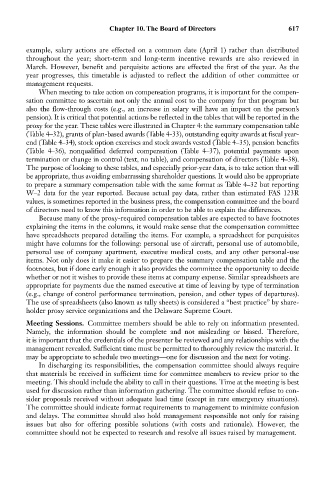Page 632 - Bruce Ellig - The Complete Guide to Executive Compensation (2007)
P. 632
Chapter 10. The Board of Directors 617
example, salary actions are effected on a common date (April 1) rather than distributed
throughout the year; short-term and long-term incentive rewards are also reviewed in
March. However, benefit and perquisite actions are effected the first of the year. As the
year progresses, this timetable is adjusted to reflect the addition of other committee or
management requests.
When meeting to take action on compensation programs, it is important for the compen-
sation committee to ascertain not only the annual cost to the company for that program but
also the flow-through costs (e.g., an increase in salary will have an impact on the person’s
pension). It is critical that potential actions be reflected in the tables that will be reported in the
proxy for the year. These tables were illustrated in Chapter 4: the summary compensation table
(Table 4–32), grants of plan-based awards (Table 4-33), outstanding equity awards at fiscal year-
end (Table 4–34), stock option exercises and stock awards vested (Table 4–35), pension benefits
(Table 4–36), nonqualified deferred compensation (Table 4–37), potential payments upon
termination or change in control (text, no table), and compensation of directors (Table 4–38).
The purpose of looking to these tables, and especially prior-year data, is to take action that will
be appropriate, thus avoiding embarrassing shareholder questions. It would also be appropriate
to prepare a summary compensation table with the same format as Table 4–32 but reporting
W–2 data for the year reported. Because actual pay data, rather than estimated FAS 123R
values, is sometimes reported in the business press, the compensation committee and the board
of directors need to know this information in order to be able to explain the differences.
Because many of the proxy-required compensation tables are expected to have footnotes
explaining the items in the columns, it would make sense that the compensation committee
have spreadsheets prepared detailing the items. For example, a spreadsheet for perquisites
might have columns for the following: personal use of aircraft, personal use of automobile,
personal use of company apartment, executive medical costs, and any other personal-use
items. Not only does it make it easier to prepare the summary compensation table and the
footnotes, but if done early enough it also provides the committee the opportunity to decide
whether or not it wishes to provide these items at company expense. Similar spreadsheets are
appropriate for payments due the named executive at time of leaving by type of termination
(e.g., change of control performance termination, pension, and other types of departures).
The use of spreadsheets (also known as tally sheets) is considered a “best practice” by share-
holder proxy service organizations and the Delaware Supreme Court.
Meeting Sessions. Committee members should be able to rely on information presented.
Namely, the information should be complete and not misleading or biased. Therefore,
it is important that the credentials of the presenter be reviewed and any relationships with the
management revealed. Sufficient time must be permitted to thoroughly review the material. It
may be appropriate to schedule two meetings—one for discussion and the next for voting.
In discharging its responsibilities, the compensation committee should always require
that materials be received in sufficient time for committee members to review prior to the
meeting. This should include the ability to call in their questions. Time at the meeting is best
used for discussion rather than information gathering. The committee should refuse to con-
sider proposals received without adequate lead time (except in rare emergency situations).
The committee should indicate format requirements to management to minimize confusion
and delays. The committee should also hold management responsible not only for raising
issues but also for offering possible solutions (with costs and rationale). However, the
committee should not be expected to research and resolve all issues raised by management.

